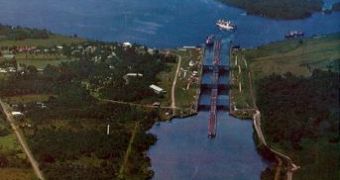The Panama Canal has been facing a capacity shortage due to the size of the new cargo ships. The third shipping lane added to the canal will be ready by 2014, 100 years later after the opening of the 51 mi (82 km) long canal, opening the era of the post-Panamax ships. Panamax is a maritime shipping standard describing the ships that can fit through the canal's current locks. But with the boom of the commercial exchange between Asia and the Americas, many transporters employ ships 50 % wider than Panamax vessels, carrying 8,000 cargo containers each.
The 5.25-billion-U.S.-dollar widening will add two new three-chamber locks at either end of the canal. The canal would double its annual capacity to over 60 billion cubic ft (1.7 billion cubic meters) of cargo.
Post-Panamax vessels now offload at ports on the West Coast of the US, goods like Japanese cars, Korean televisions and Chinese toothpaste that are carried by rail across the U.S. and Canada.
Through the third lane, goods will reach the East Coast ports directly, decreasing retail prices. Brazil and Venezuela, with their rising shipments of oil, grain and other raw materials to China are also funding on the expansion. But which will be the environmental effects? The project started with the reforestation of a buffer zone that hugs either side of the waterway. The new forests maintain humidity in the area, even in the driest years, not to mention that Panama City takes its drinking water from the canal.
"The new forest will act as a sponge, storing rainfall during Panama's rainy season and slowly releasing it into the canal during the dry season. Smaller vegetation is also being planted along the canal's banks. You need that vegetation because it holds the soil in place. If that soil gets washed away by rain, then you're going to have sedimentation flowing into the water and the amount of water in the canal is going to diminish. Deforestation has been a problem not just near the canal but countrywide. But we are monitoring the issue closely to keep both the water quantity and quality in check," explained the canal engineer Ilya Espino de Marotta.
Panama isthmus, the bridge between North and South America, is also a migrating route for species of birds and mammals and harbors crucial habitats for species like jaguars and eagles.
"Engineers and hydrologists with the Panama Canal Authority have done their homework. There's plenty of water flowing through the canal watershed over the course of a year. The big issue is the dry season, especially during 'El Ni?o' years. In the past they've have had to impose draft restrictions where boat captains knew before they arrived in Panama that they had to carry less cargo." said Jefferson Hall, a forest ecologist at the Smithsonian Tropical Research Institute (STRI) in Panama.
"Some researchers say areas that have been deforested should remain so-that the current hydrological function of the forest and adjacent grasslands and pastures should remain as it is. While that issue is debated, we're recommending that cattle farmers working near the canal consider a switch to traditional agriculture as the canal expansion moves ahead." said Robert Stallard of the U.S. Geological Survey.
"That would likely permit the soil to retain more water for both canal operations and Panama City's drinking water," Stallard said.
"The canal's current locks dump about 50 million gallons (190 million liters) of water into the sea each time a boat passes through," said Jorge de la Guardia, supervisor at the construction of the expansion.
The main work of the new locks will be novel water-saving basins.
"The basins will fill the lock chambers each time a post-Panamax vessel moves through using state-of-the art water-pumps. 60 % of the water used on each transit through the new locks will be reused. We will actually use about 7 % less water than we do with the locks today. The remainder will eventually return to the sea, which will allow us to maintain more predictable water levels on the canal. This is a method using technology that's already been proven to work in Europe." said de la Guardia.
"The technology being added in the expansion means no reservoirs will be excavated to supply the new locks with water." said Panama's President, Martin Torrijos.
The zone edging the canal is a high-security area where no one is permitted to live. Still, 186,000 people live on islands within the canal or on the banks of the lakes Gatun and Alhajuela, the result of a dam farther north. "Only a small number of people living in 20 buildings on the canal's property will have to move," said de la Guardia. This situation is due to the fact that the level of Gatun Lake, making about half of the canal's transit distance, will rise by a few ft with the new project. Some are worried about the risks of saltwater contamination to Gatun Lake.
"The billion U.S. dollars of revenue generated each year will grow exponentially once "post-Panamax" ships-and their higher tolls-arrive." said Max Newman heads the Canal Authority's tugboat operations.
"After years of control by the U.S. leading up to Panama's assumption of full control of the waterway in 1999, Panama has shown it can operate the canal efficiently and profitably. We are more than capable of completing this project. If we don't move forward, we Panamanians will miss out on the revenue the new, bigger ships will bring into the country. If we don't expand, imagine how many more gallons of gasoline will send out greenhouse gases as post-Panamax ships navigate around the entire landmass of South America."

 14 DAY TRIAL //
14 DAY TRIAL //